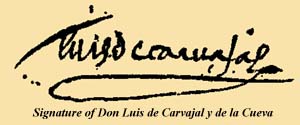 |
Don Luis de Carvajal
Conquistador
extraordinaire
Founder of the city of Monterrey
Advocate of Indian rights
staunch Defender of the Catholic Faith
but alas!
of Jewish ancestry
and inevitably,
Victim of the Mexican Inquisition
|
|
|
Set in 16th-century Mexico or New Spain
as it was then called, The Conquistador is based on a true
story.
It is the year 1579 as the opera begins. King Philip of Spain
ordains Don Luis Governor and Captain-General of New Leon, in
New Spain. His royal mandate:
His charter allows him to take with him
one hundred people without the requisite certificates of blood
purity (limpieza de sangre) as proof of their non-Jewish
ancestry. Among these are his sister Dona Francisco de Matos and
her family who, unbeknownst to him, are secretly practicing Judaism.
(Don Luis was sent to Lisbon as a child after his father's early
death, where he was raised by his maternal uncle as a devout Catholic.)
In Mexico, he scores victories over the Indian natives, pacifying
the Northern Frontier. A man of power, he conquers ruthlessly
with the sword but rules with a sense of compassion for the natives.
In the opera, his advocacy of Indian rights earns him an ally
in the person of the Franciscan friar Bernardino de Sahagun (a
historical figure known for his ethnographic works). However,
Don Luis' sympathy for the Indians does not please the Spanish
colonists who urge the Viceroy to strip him of power. The Viceroy,
who does not look kindly on Don Luis' courtship of his niece Dona
Elena, conspires with the Chief Inquisitor - although they have
no evidence to prove it, they agree to use the de Matos family's
non-possession of limpieza de sangre certificates as an
actionable cause for Don Luis' removal from power. As Don Luis
prepares for a campaign to quell a rebellion in the northern frontier,
the Viceroy orders him to remain in Mexico City. Don Luis resolves
to defy the orders despite his beloved Elena's pleas to the contrary.
Meanwhile in the town of Tampico, the de Matos family, ensconced
in a life devoid of luxury and excitement, find solace in their
secret lives as Jews. Dona Isabel, the eldest daughter and herself
a young widow, is Don Luis' favorite niece. Both she and her mother
Dona Francisca are determined to bring back Don Luis to the fold.
As is common practice among secret or crypto-Jews of the time,
one brother, Gaspar, is a Catholic priest. Purposely shielded
by the family from the truth, he now harbors suspicions. Two other
brothers Alvaro and Baltasar, soldiers in Don Luis' campaigns
of pacification, are secret Judaizers.
Before leaving for the frontier, Don Luis visits Tampico with
his adjutant Felipe. Dona Isabel confronts Don Luis with the family
secret and urges him to embrace the faith of his ancestors. Outraged
by this act of blasphemy, he strikes her violently and renounces
the family. He leaves for the frontier deeply conflicted by these
revelations. As expected, he sweeps away the rebellion but peace
of mind eludes him. As he ponders the dualities of his life, he
is arrested and led off in chains to prison. Sahagun visits him
in prison along with Dona Elena who reaffirms her love and bids
him farewell for she is being sent back to Spain. The charges
against Don Luis remain unspoken. But his aide Felipe denounces
his commander in order to save his career, and accuses Isabel
and the rest of the de Matos family of being secret Jews.
At the Inquisition, under torture, Dona Isabel confesses and implicates
her mother. The rest of the family confess thereafter, but hold
steadfast in their refusal to denounce either Gaspar the priest
or their uncle Don Luis.
Don Luis is likewise tried by the Tribunal of the Inquisition.
Convinced he will be acquitted, he reaffirms his Christianity.
Nevertheless, the Tribunal strips him of all his honors and sentences
him to exile in Spain for the crime of aiding and abetting Jews.
Sadly, a few months later he dies of unknown causes in his prison
cell, tormented by nightmares and torn to the very end between
his Christian faith and his Jewish roots. The rest of his family
are later burned at the stake.

|
![]()